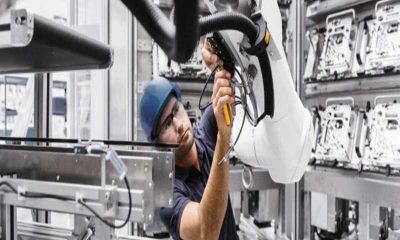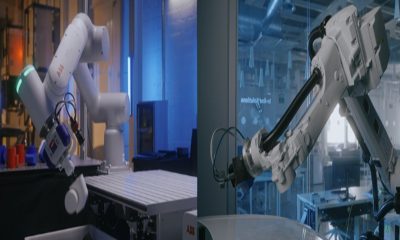From August 8 to 12, 2025, the 2025 World Robotics Conference (WRC 2025) was held at the Beiren Yichuang International Convention and Exhibition Center in the Beijing Economic and Technological Development Zone. Under the theme of “Making Robots Smarter, Embodied Intelligence Smarter,” the conference brought together the world’s leading robotics companies and 1,500 robotic products. The conference brought together the wisdom of global experts to promote technological and industrial innovation, elevating China’s robotics industry to a leading position in the future economy and technology, and enabling it to participate in global technological competition.
Kepler and its K2 Hornet robot appeared at WRC 2025, presenting a feast of hardcore industrial prowess. At the exhibition, the K2 Hornet demonstrated human-level material handling and logistics sorting operations, and also interacted with the audience for a chance to win a blind box package. The K2 Hornet handled every aspect with ease, driving popularity to the Kepler booth, attracting a constant stream of visitors and attracting numerous media outlets to cover the K2 Hornet’s spectacular performance.
During WRC 2025, the world’s first 4S store equipped with intelligent robots was officially unveiled. The K2 Bumblebee made its first appearance there, setting up a booth at the Beijing Yizhuang 4S store to expand its display range, demonstrating the robot’s progress from “completing tasks” to “efficient and precise operations,” continuing to win fans with its strength.
Charge for 1 hour, work for 8 hours straight, demonstrating its endurance.
At the WRC 2025 event, the K2 Hornet demonstrated its workflow in a logistics handling scenario. Its arms steadily lifted a 30-kilogram metal box and, using sensors to locate it, precisely slotted it into the corresponding shelf slot. The K2 Hornet was able to accomplish these maneuvers thanks to the seamless collaboration of two actuators: a linear actuator that provides lifting force comparable to that of an industrial worker, and a rotary actuator responsible for fine-tuning the angle. Working in tandem, these two actuators ensure both load-bearing strength and energy efficiency, achieving a “charge for 1 hour, work for 8 hours straight.”
The K2 Hornet’s 8-hour battery life is the result of comprehensive consideration of practical application requirements, technical feasibility, and user habits. This 8-hour battery life is particularly crucial in key deployment scenarios such as logistics and industry, offering the optimal balance between operational efficiency, cost control, and technical feasibility. This 8-hour battery life is a crucial step in the humanoid robot’s transition from “lab prototype” to “commercial product.”
A trinity of full-body intelligence systems, achieving true embodied intelligence
During the live demonstration, the K2 Hornet handled tasks with ease, whether carrying goods, sorting them, or selecting specific items. This capability stems from the full-body intelligence system Kepler has built for it, comprising a humanoid body, a multimodal brain, and the ability to continuously evolve.
The core of this humanoid body is the K2 Hornet’s skeletal system. Its 52 degrees of freedom, six-jointed single-leg structure, and seven-jointed single-arm structure provide it with human-like degrees of freedom. Its dexterous hand, with 11 degrees of freedom and a 25-point force contact matrix per finger, can mimic the fine movements of a human finger. A full stack of in-house developed high-density joints, including core components such as the in-house developed planetary roller screw actuator, ensures this metal body is both powerful and flexible.
The K2 Hornet’s brain utilizes a layered Vision-Language-Action (VLA) model. In embodied decision-making, the reasoning layer leverages the Vision-Language Model (VLM) for deep reasoning and planning, while the execution layer rapidly generates action commands based on the action module of the Diffusion Transformer (DiT). The K2 Hornet’s “decision-execution” chain achieves millisecond-level response times, similar to how humans think before acting. Kepler is currently collaborating with several renowned domestic leading inference logic models on the “brain” side, laying a solid foundation for the K2 Hornet’s brain capabilities.
The K2 Hornet’s continuous evolution relies on a dual data flywheel mechanism. First, training based on simulated data equips it with the ability to perceive and understand common scenarios and understand language commands. Second, it hone its specialized skills based on massive amounts of real-world data. This “simulation training + real-world upgrade” model enables the K2 Hornet to continuously improve its proficiency, similar to professional industrial workers, becoming an “operation expert” in various fields.
From “understanding” to “execution,” understanding human language
During an interactive game with the audience, the K2 Bumblebee, upon hearing a random utterance from an audience member, “Please bring me package number 2,” adjusted its grip using its 11-degree-of-freedom dexterity, accurately grasped the package, and gently placed it in the designated area, drawing amazement from the audience. This instant response to natural language made the onlookers truly realize that robots understanding human speech is no longer just science fiction.
In reality, after hearing the audience’s commands, the K2 Bumblebee needs to identify visual information such as the color and label of each package to ensure that the package it grasps is the one with the user’s designated number. Another challenge is that traditional automated equipment struggles to accurately estimate the pose of small, soft packages with flexible packaging, smooth surfaces, and the tendency to deform.
Enabling robots to understand human intentions requires a comprehensive “translation system.” The K2 Hornet’s outstanding performance in interactive situations is based on its sophisticated processing pipeline, a closed loop from “understanding” to “execution” that ensures precise and controllable action.
First, in the command decoding phase, a microphone array captures voice signals, which are converted into text through speech recognition and then analyzed by a natural language processing model. During an interaction, when a user says, “Please bring me package number 2,” the system automatically parses three key pieces of information: the action (handling), the object (the package at position 2), and the target (the area on the package tray).
In the environmental perception phase, the RGB-D data collected by the K2 Hornet’s binocular cameras is processed by a world model to generate a three-dimensional map of the environment. This allows the robot to not only identify object locations but also determine material hardness—reducing grip force when grasping cardboard boxes and automatically tightening the grip when handling metal parts.
In the action generation phase, a large language model (LLM) converts abstract commands into specific steps, which are then converted into high-frequency motor signals to drive the coordinated movement of 52 joints.
Moving towards practical implementation, empowering social production
Humanoid robots, as the optimal vehicle for embodied intelligence, are profoundly reshaping the path of global industrial modernization. At WRC 2025, the China Electronics Society released the “Top Ten Potential Application Scenarios for Humanoid Robots in 2025,” which include general industrial operations, automotive manufacturing, 3C manufacturing, shipbuilding, petrochemicals, power generation, safety and emergency response, commercial services, home services, and agricultural production, charting a future of widespread humanoid robot adoption.
The K2 Bumblebee is the world’s first commercially available planetary roller screw humanoid robot, marking the industry’s transition from “concept demonstration” to “practical implementation.” The K2 Bumblebee’s capabilities have been verified in field trials by leading companies across multiple industries, including logistics handling, intelligent sorting, stamping and loading, education and research, and exhibition hall reception. Kepler’s impressive demonstration at WRC 2025 marks a new chapter in the K2 Bumblebee’s commercialization.
With the conclusion of WRC 2025, pre-orders for the K2 Bumblebee have officially begun mass production. As more K2 Hornets enter factory floors, they will fully demonstrate the value of humanoid robots in a variety of practical applications. Kepler will continue to advance the development of embodied intelligence, making humanoid robots reliable production partners for humans and accelerating the pace of industrial development.










